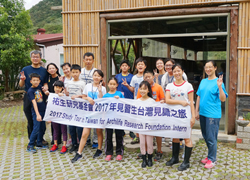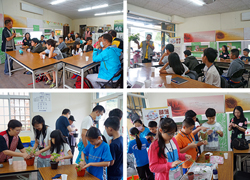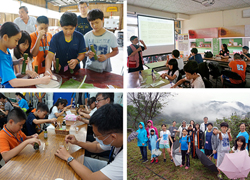
10月份見識之旅活動,於2017年10月14日由呂明澐小姐帶領14位祐生見習生及家長們,進行尖石那羅部落巡禮暨純淨香草種植體驗之旅。出發當日天氣陰雨,然見習生們及其家長仍準時集合並出發。活動開始之初,領隊呂明澐小姐提醒本次活動注意事項及觀察重點,先行建立見習生的背景知識。
For the study tour of October 14, 2017, Ms. Lu Ming-yun led 14 ARF interns and their parents on a tour to visit Naro Tribe and experience herb growing in Jianshih. It was rainy on the day of the tour, and the interns and their parents were on time for the departure. At the start of the day'sactivities, team leader Ms. Lu Ming-yun reminded everyone about things to note and what to observe, and provided the interns some general background knowledge.

本次行程以那羅部落為參訪主軸,那羅部落是一個以泰雅族為主的部落,二十年前即開始種植香草,卻因颱風侵襲,幾乎摧毀所有花田,經過十多年的努力,當地居民除了重振部落裡香草產業,更讓世界看見來自台灣的優質香草。行程一開始,由那羅香草合作社理事長,以投影片介紹部落的產業發展,並講述民國93年遭受艾利颱風重創後的情況,以及居民重建家園與香草產業的艱辛。隨即進行香草種植DIY體驗,導覽老師藉由不同的香草植株,個別說明其療效、用途與適合生長的環境,亦教導香草種植的小訣竅。透過香蜂草分株、檸檬馬鞭草扦插及亞歷山大野草莓點播,讓眾人認識香草植物繁殖的方式,並可觀察其後續發根、長苗茁壯的過程。
The focus of the tour was the visit to Naro Tribe, which is primarily an Atayal tribe. The tribe began planting herbs two decades ago but all its herb fields were virtually destroyed due to a destructive typhoon. After over a decade of hard work, the local residents have not only reinvigorated the herb industry but also allowed the world to notice the superior herbs from Taiwan. The tour began with the chairman of Naro Herbs Cooperative introducing the industrial development of the tribe through the slides. He described what happened after the devastation of Typhoon Aere in 2004, and the hardship residents went through to rebuild their homeland and the herb industry. Everyone then tried out herb planting. The tour guide explained the therapeutic effects and uses of various herbs, and the ideal environment for growing them, and also gave everyone tips for growing herbs. By dividing the lemon balm(Melissa officinalis), cutting the lemon verbena(Verbena officinalis), and seeding the wild strawberry(Fragaria vesca 'Alexandria'), everyone learned about herb propagation, and were able to observe the rooting and growing of the plants.

中午飯後,眾人跟隨導覽老師的腳步走訪部落,她沿途指出當年艾利颱風摧毀的房舍所在處,亦介紹路邊隨處生長的香草植物,其中針對路旁一株人們經常食用,卻鮮少見到仍為植株樣貌的植物—薏仁,做詳細說明,使見習生們了解薏仁不僅是具食療功效的食材,亦是原住民經常使用於串珠的材料。接著至精油萃取工廠,進行蒸餾萃取過程導覽,廠長說明香草植物如何經過蒸餾及油水分離形成精油與純露,並比較二者之間質地和功效的差異,亦講述一公斤的精油需要幾千公斤的花朵才能製成,精油取之不易的珍貴性由此可見。隨後進行身體乳液及香水DIY,起先導覽老師介紹本次DIY之身體乳及香水的內含成分與功效,並與市售產品做比較,接著,眾人按導覽老師所述步驟,仔細完成自製乳液與香水,藉由本次體驗,見習生們對於乳液和香水的成分及製作過程有了初步的認識。至此,本日活動已近尾聲,大家一起合照留念後各自返家,並期待於下次見識之旅再相見。
After lunch, everyone followed the tour guide to the tribe. Along the way, she pointed out the housing that was destroyed by Typhoon Aere, and the herbs growing on the sides. She particularly mentioned a plant on the roadside that people often eat but rarely see –Job'stears. She explained that Job'stears is not only a therapeutic food but is also often used by the indigenous peoples as a material for bead stringing. In the essential oil extraction plant, the manager explained how the herbs are distilled to separate the essential oils and pure essence, and compared the differences in their quality and effect. The manager also explained that several thousand kilograms of flowers are required to make one kilogram of essential oil, emphasizing the preciousness of their extraction. In the DIY activity that followed, the tour guide introduced the ingredients and effects of the body lotion and perfume that everyone was making, and compared them to products sold in the market. Next, following the instruction of the tour guide, everyone completed their DIY lotion and perfume. The interns gained an initial understanding of the ingredients and process of making lotion and perfume through the experience. At this point, the day's itinerary came to an end. Everyone returned to home after taking a group photo and looked forward to the next study tour.